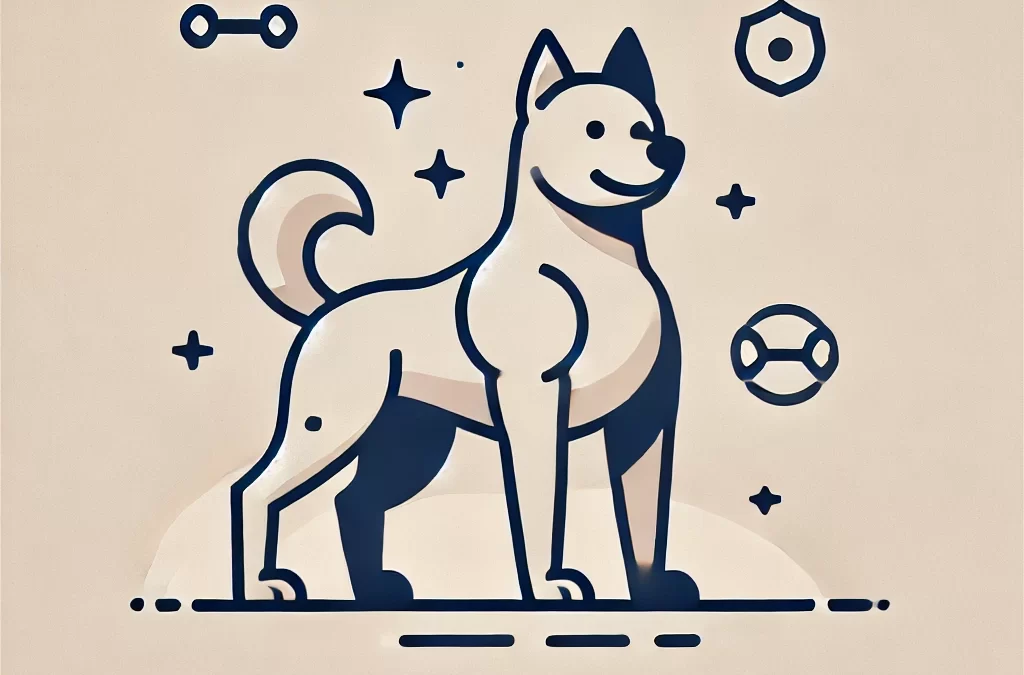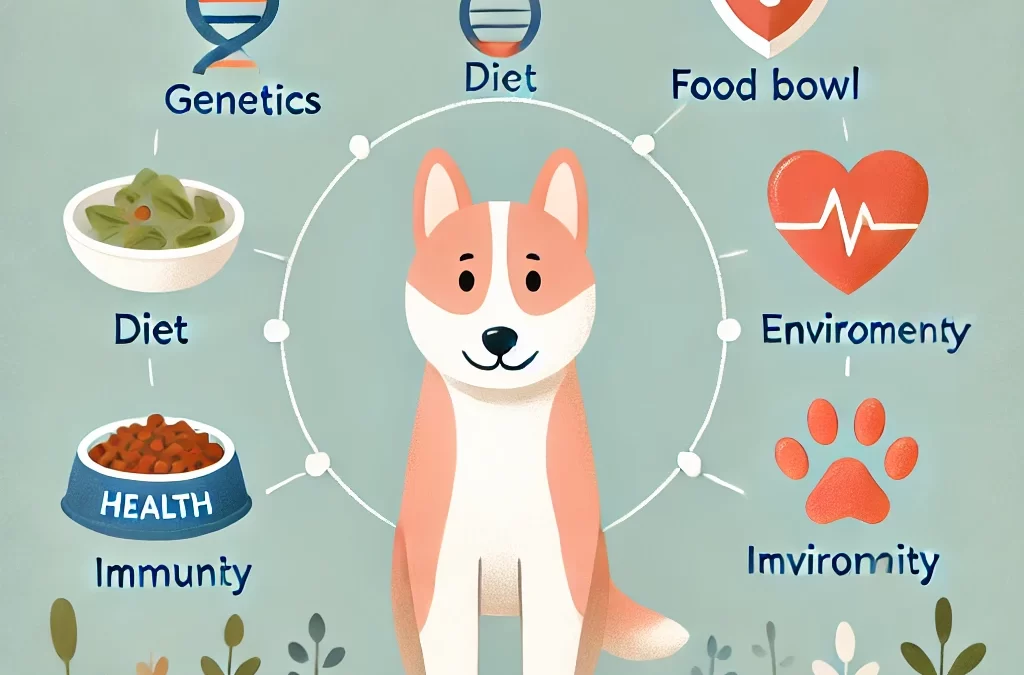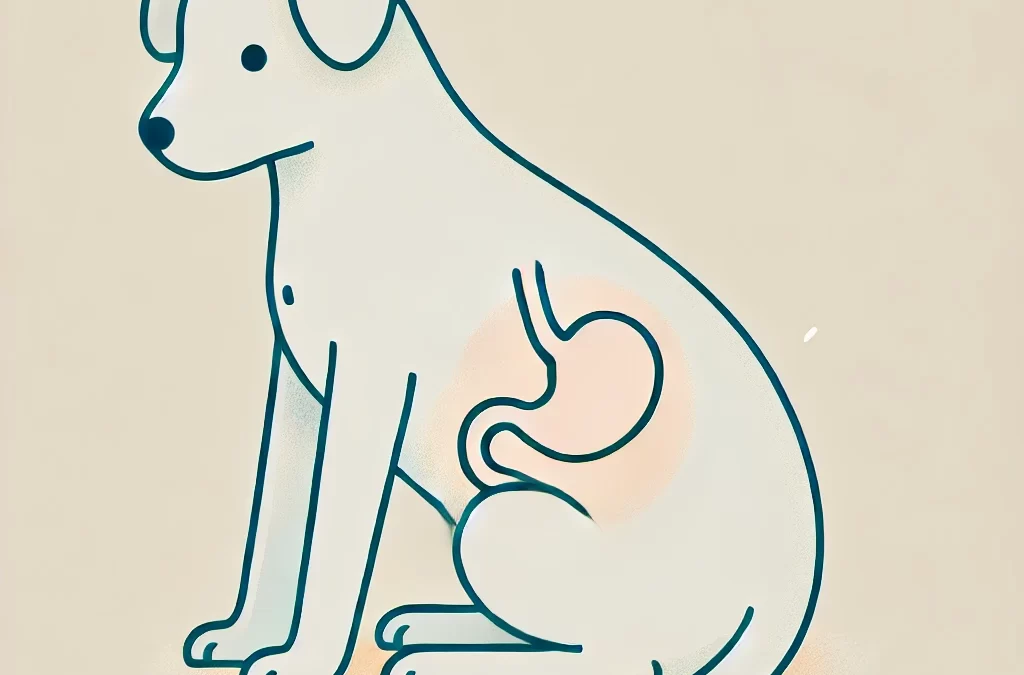
by TCMVET | Nov 13, 2024 | Food & Health
Just like humans, pets can benefit greatly from probiotics, the “good bacteria” that support gut health, immunity, and overall wellness. While commercial probiotics are popular, natural sources of probiotics are emerging as an effective and holistic approach. This article dives into what natural probiotics are, where they can be found, and how they can enhance your pet’s health naturally.
1. What Are Natural Probiotics for Pets?
- Definition: Natural probiotics are live beneficial bacteria found in naturally fermented foods, herbs, and plants.
- How They Work: These microorganisms help balance the gut microbiome, improve digestion, enhance immune response, and can even positively impact mood.
- Difference from Commercial Probiotics: Natural probiotics are sourced from whole foods and are less processed, offering a closer-to-nature solution.
2. Benefits of Natural Probiotics for Pets:
- Better Digestion: Probiotics can aid in breaking down food, absorbing nutrients, and reducing digestive issues like gas or diarrhea.
- Stronger Immunity: A balanced gut microbiome strengthens the immune system, helping pets fight off infections more effectively.
- Allergy Relief: Regular intake of probiotics can alleviate skin allergies by reducing inflammation in the gut, where many immune responses originate.
- Mood and Behavior: Research shows a connection between gut health and mood, suggesting probiotics can have a calming effect on pets.
3. Sources of Natural Probiotics for Pets:
- Yogurt and Kefir: Plain, unsweetened yogurt and kefir are rich in probiotics like Lactobacillus acidophilus and Bifidobacterium. These can support digestive health if given in small, safe amounts.
- Fermented Vegetables: Small amounts of fermented vegetables like sauerkraut (unsalted) can offer probiotics, but these should be introduced cautiously.
- Apple Cider Vinegar: Raw apple cider vinegar contains enzymes and beneficial bacteria, but it should be diluted before use to prevent digestive upset.
- Herbs and Soil-Based Organisms: Certain herbs like dandelion root and chicory root contain prebiotics, which nourish beneficial bacteria. Additionally, soil-based probiotics found in pet-safe organic soil can naturally support gut health.
4. How to Introduce Natural Probiotics to Your Pet’s Diet
- Start Small: Introduce small amounts and monitor for any digestive upset or reactions.
- Observe and Adjust: If your pet seems to benefit, gradually increase the frequency or amount as advised by a veterinarian.
- Consistency is Key: Regular, consistent doses of natural probiotics tend to yield the best results, so find a method that works with your pet’s daily routine.
5. When to Consider Natural Probiotics Over Supplements
- For Sensitive Pets: Pets that don’t tolerate commercial probiotic supplements well might respond better to natural sources.
- Post-Antibiotic Treatment: After a round of antibiotics, natural probiotics can help restore the gut microbiome.
- Daily Health Maintenance: If you’re looking for a preventive approach, natural probiotics can be a gentle, effective option for daily health.
6. Safety Tips and Things to Watch Out For
- Avoid Additives: Stick to plain, unflavored, and unsweetened probiotic sources, as additives like sugar and artificial flavors can harm pets.
- Consult Your Vet: Always check with your vet, especially if your pet has any underlying health conditions or allergies.
- Monitor for Side Effects: In rare cases, pets may experience mild diarrhea or bloating as their systems adjust to new probiotics.
Conclusion:
Natural probiotics offer a holistic way to boost your pet’s health, supporting digestion, immunity, and even mood. By introducing safe, natural sources of probiotics, you’re providing a more natural path to wellness. With patience and consistency, these natural helpers can become an essential part of your pet’s routine for a happier, healthier life.

by TCMVET | Nov 13, 2024 | Dog Cancer & Tumors
Fatty lumps, or lipomas, are one of the most common non-cancerous growths in dogs, particularly as they age. Pet owners often feel a sense of alarm when they discover these lumps, but most lipomas are benign. In this article, we’ll explore what these lumps feel like, how to distinguish them from other growths, and tips on when to consult a veterinarian.
1. What Are Fatty Lumps?
- Definition of Lipomas: Lipomas are soft, fatty deposits that form under the skin, usually in older or overweight dogs.
- Common Locations: Typically found on the torso, armpits, and limbs but can appear in various locations.
- Cause: Though exact causes aren’t fully known, they may be linked to age, breed, genetics, and weight.
2. The Feel of Fatty Lumps:
- Soft and Movable: Lipomas are generally soft and slightly squishy, feeling somewhat like a lump of dough under the skin. They’re easy to move with a gentle push, which often differentiates them from harder, less mobile growths.
- Not Painful: Unlike cysts or abscesses, lipomas are not painful unless they press on a nerve or joint.
- Consistent Texture: Lipomas usually feel the same throughout, with a homogenous, doughy texture.
3. Differences Between Lipomas and Other Types of Lumps:
- Cysts: Often firmer, cysts can be fluid-filled and sometimes have a central punctum, unlike the uniformity of a lipoma.
- Abscesses: These are usually painful and feel warm to the touch, often accompanied by redness.
- Cancerous Growths: Malignant lumps can feel harder, are often fixed in place, and can grow quickly or irregularly. Tumors might feel irregular in shape or firm.
- Fibromas: These benign tumors feel firmer than lipomas and are less mobile but are usually harmless.
4. When Should You Worry?
- Growth Rate: If a lump grows quickly, changes shape, or becomes painful, it’s best to consult a vet immediately.
- Location Concerns: Lumps near joints or in areas that affect mobility may require removal or monitoring.
- Multiple Lumps: Multiple lipomas are common in some breeds, but if new lumps appear rapidly, consider a veterinary check.
5. Diagnosing Lipomas:
- Veterinary Examination: A vet can confirm if a lump is a lipoma through palpation.
- Fine Needle Aspiration (FNA): For a more definitive diagnosis, FNA can collect cells from the lump for analysis, providing clarity on whether the lump is benign or requires further investigation.
6. Should Lipomas Be Removed?
- When Surgery is Needed: Generally, lipomas are left alone unless they cause discomfort, restrict movement, or grow excessively.
- Minimally Invasive Options: Newer methods, like liposuction or steroid injections, may help reduce lipomas in some cases.
7. Prevention and Health Tips for Reducing Lipomas:
- Maintain a Healthy Weight: Obesity is a known risk factor for lipomas.
- Regular Check-Ups: Regular vet visits allow for early detection and monitoring of any new growths.
- Balanced Diet and Exercise: A balanced diet and consistent exercise can help prevent obesity, which may reduce the likelihood of lipomas.
Conclusion: While fatty lumps in dogs can be concerning, they’re often harmless and easy to manage. By understanding the feel, causes, and symptoms of lipomas, dog owners can make informed decisions about their pet’s health. If you’re unsure about a lump on your dog, always seek professional advice for peace of mind.

by TCMVET | Nov 12, 2024 | Dog Cancer & Tumors
For pet owners looking to help their dogs develop lean muscle, enhance strength, or recover from an injury, the idea of muscle-building supplements might seem intriguing. While not a standard for every dog, these supplements can benefit certain breeds, high-energy dogs, working dogs, and even those in recovery. Here, we’ll explore the benefits of muscle-building supplements for dogs, key ingredients to look for, and tips for choosing safe and effective products.
1. Why Muscle Matters for Dogs
A healthy muscular system is vital for every dog, not just the active or athletic ones. Muscles help support joints, improve endurance, and maintain overall mobility. For dogs involved in agility, hunting, or other high-intensity activities, strong muscles can help prevent injuries and improve performance. Additionally, older dogs, those recovering from surgery, and dogs with certain conditions like arthritis can benefit from muscle support to maintain strength and reduce discomfort.
2. Who Should Consider Muscle Builder Supplements?
Muscle-building supplements aren’t necessary for all dogs, but they can be beneficial for:
- Active Breeds: Breeds like Border Collies, German Shepherds, and Labradors that are naturally high-energy and thrive with a structured exercise routine.
- Working Dogs: Police, military, and service dogs often require enhanced physical capabilities.
- Senior Dogs: Aging dogs can lose muscle mass over time. Supplements can help maintain muscle tone, which supports joint health.
- Dogs in Recovery: Dogs recovering from surgery or injury may need additional support to rebuild strength and mobility.
3. Key Ingredients to Look For
Not all muscle-building supplements are created equal, so understanding ingredient benefits can help in selecting a quality product. Here are the top ingredients that can support muscle health:
- Amino Acids: Building blocks of protein, amino acids like L-carnitine and L-glutamine aid in muscle development and recovery. These are crucial for dogs building or maintaining lean muscle.
- Creatine: Although commonly associated with human bodybuilding, creatine is a natural compound that can help dogs improve muscle performance. It’s especially beneficial for short bursts of energy, such as sprinting or agility training.
- Omega-3 Fatty Acids: These healthy fats are known to reduce inflammation, which can help with recovery after exercise. Omega-3s can also support joint health, making them a good addition to a muscle-focused supplement.
- Protein Sources: High-quality protein sources like chicken, fish, or beef provide essential nutrients for muscle growth and repair. Some muscle-building supplements incorporate dehydrated protein powder.
- Joint Support Compounds: Ingredients like glucosamine and chondroitin aren’t directly for muscle building, but they support joint health, which is vital for active dogs who want to build and sustain muscle.
4. Choosing the Right Muscle Builder Supplement
When selecting a supplement, consider these tips to ensure you’re providing the safest and most effective product for your dog:
- Choose Dog-Specific Products: Some human muscle-building supplements can be harmful to dogs. Look for products specifically formulated for canine physiology.
- Check for High-Quality Ingredients: The fewer fillers, artificial flavors, or preservatives, the better. A good supplement should be rich in whole ingredients.
- Talk to Your Vet: Before starting any supplement, consult your vet, especially if your dog has any pre-existing health conditions.
- Start Slowly: Gradually introduce any new supplement to observe how your dog responds, and avoid giving more than the recommended dose.
5. Supplementation vs. Natural Diet
While supplements can provide a convenient way to boost your dog’s muscle health, a balanced diet is foundational. High-protein diets, including lean meats, eggs, and some fish, can naturally support muscle health. Supplements are most effective when combined with good nutrition and a proper exercise routine.
6. Building Muscle Through Exercise and Training
Supplements alone can’t build muscle; a well-structured exercise routine is essential. Focus on activities that engage the entire body, such as:
- Weighted Walks or Hiking: Attaching a light backpack can provide gentle resistance for healthy dogs.
- Agility Training: Encourages flexibility and builds strength while keeping your dog mentally stimulated.
- Swimming: A low-impact exercise, swimming is excellent for muscle growth and joint health.
Conclusion: Building a Stronger, Healthier Dog
Muscle-building supplements can be a valuable addition for dogs needing a strength boost, but they work best when paired with balanced nutrition and exercise. By carefully choosing high-quality supplements and keeping your vet informed, you can support your dog’s muscle health, ensuring they stay active, strong, and ready for life’s adventures.

by TCMVET | Nov 12, 2024 | Dog Cancer & Tumors
Cancer is one of the most challenging diseases for humans and pets alike, and it’s particularly heartbreaking when it affects our beloved dogs. But understanding why and how cancer develops in dogs can shed light on prevention and provide insight into early detection. While there’s no surefire way to prevent cancer, let’s explore the main contributing factors, emerging research, and ways we can help reduce risks.
1. Genetics: The Influence of Breed and Family History
Some breeds have a higher predisposition to cancer. For example, breeds like Golden Retrievers, Boxers, and Rottweilers are genetically inclined to develop certain cancers. Research suggests that inherited genetic mutations play a significant role in these tendencies. A study published in Canine Genetics and Epidemiology revealed that particular breeds have shared genetic traits that make them more susceptible to tumors. As a result, a dog’s lineage can increase its risk, meaning pet parents of certain breeds need to be extra vigilant with regular vet check-ups.
2. Environmental Factors: Carcinogens and Everyday Toxins
Dogs are exposed to environmental toxins just like humans. Common culprits include secondhand smoke, certain cleaning products, pesticides, and pollution. Dogs, with their close contact with floors and outdoor surfaces, can easily ingest or inhale harmful substances, unknowingly bringing toxins into their bodies. There is also mounting evidence that shows a direct correlation between exposure to specific carcinogens and increased cancer risks in dogs.
Actionable Insight: To minimize exposure, consider choosing natural cleaning products, avoiding smoking around pets, and ensuring your dog’s play areas are free from pesticides.
3. Diet: The Role of Nutrition in Cancer Prevention
What a dog eats can have profound effects on their health, influencing everything from immune function to cellular health. Poor-quality food, high in fillers and artificial additives, can contribute to cellular mutations and inflammation, potentially leading to cancer. On the other hand, a balanced diet rich in antioxidants, omega fatty acids, and natural proteins can support cellular repair and immune defenses.
Dietary Recommendation: Consider switching to high-quality, organic, or even home-cooked meals tailored to meet your dog’s nutritional needs. Always consult with a veterinarian for guidance on the best diet.
4. Hormonal Influences and Reproductive Health
Hormones are powerful chemical messengers in the body, and they can influence tumor growth. Studies have shown that spaying or neutering at the appropriate age can reduce the risk of certain cancers, such as mammary or testicular cancers. However, the timing of these procedures is essential, as early spaying or neutering has been linked with an increased risk of other cancers, such as osteosarcoma.
Balanced Decision: Talk with your vet about the best time for spaying or neutering your dog, as timing may vary depending on breed and individual health.
5. Infections and Viruses
Certain infections and viruses are known to be carcinogenic. In dogs, viruses like the canine papillomavirus can cause warts that may develop into malignant tumors in rare cases. Additionally, infections that cause chronic inflammation can lead to cellular changes and mutations over time, potentially leading to cancer.
6. Aging: The Inevitable Factor
Age is one of the most significant risk factors for cancer in dogs. With improvements in veterinary care, dogs are living longer, and with age comes an increased likelihood of cancer. As a dog’s cells age, the mechanisms for repairing DNA damage can become less efficient, making it easier for cancerous mutations to occur.
Preventative Steps and Lifestyle Changes for a Healthier Life
While not all cases of cancer are preventable, certain lifestyle adjustments can help reduce risks. Here are some preventative measures that could promote long-term health:
- Routine Veterinary Care: Regular check-ups help detect any abnormal growths or early warning signs.
- Healthy Diet Choices: Choose food high in essential nutrients, free of artificial additives and fillers.
- Maintain a Clean Environment: Use non-toxic products and avoid exposing your dog to harmful chemicals.
- Exercise Regularly: Keeping your dog active supports a robust immune system, vital for fighting off diseases.
Conclusion: Knowledge as Our Best Defense
Understanding the factors that contribute to cancer in dogs can help us make informed choices and, where possible, reduce the risk. While genetics and age are beyond our control, we can take steps to ensure our dogs lead healthier, longer lives. By remaining vigilant, prioritizing quality care, and fostering a toxin-free environment, we can give our dogs the best chance at a cancer-free life.

by TCMVET | Nov 11, 2024 | Dog Cancer & Tumors
A diagnosis of a splenic tumor in a beloved dog can be heart-wrenching, as these tumors often pose a serious health risk. However, gaining an understanding of the types of splenic tumors, survival rates, and potential treatments can help dog parents make the best choices for their pet’s wellbeing. In this article, we’ll explore splenic tumors in dogs from a fresh perspective, focusing on the realities and options that can provide both clarity and hope.
1. What Are Splenic Tumors?
- Hemangiosarcoma: A malignant and aggressive tumor type, hemangiosarcoma is unfortunately common in canine spleens and often spreads rapidly to other organs.
- Hemangioma and Splenic Masses: Benign tumors and masses can also form on the spleen. Though these do not spread like hemangiosarcoma, they can rupture, leading to internal bleeding.
- Lymphoma: This type, arising in the lymphatic system, may also affect the spleen, adding complexity to the condition.
2. Recognizing Symptoms Early
- Subtle Symptoms: Splenic tumors are often asymptomatic until they reach an advanced stage. Symptoms may include lethargy, loss of appetite, and weight loss.
- Acute Crisis: In cases where the tumor ruptures, symptoms can escalate rapidly. Pale gums, collapse, abdominal swelling, and labored breathing may signal internal bleeding, requiring immediate veterinary attention.
3. Survival Rates and What They Mean
- Splenic Hemangiosarcoma: With hemangiosarcoma, the prognosis is often guarded due to its aggressive nature. Median survival rates with surgery alone can range from 2-3 months.
- With Chemotherapy: Combining surgery with chemotherapy can extend survival, sometimes offering 6-12 months, depending on the individual dog’s response.
- Benign Tumors and Masses: Survival rates for benign masses are considerably more optimistic, as surgical removal can often provide a complete solution without recurrence.
4. Exploring Treatment Options
- Surgical Intervention: Splenectomy, or removal of the spleen, is the most common treatment for splenic tumors. It can provide immediate relief from symptoms and prevent further complications from a ruptured mass.
- Chemotherapy: This is often recommended for malignant tumors like hemangiosarcoma to control the spread, though it may not be curative. Some dogs tolerate chemotherapy well, showing few side effects.
- Alternative Therapies: Many pet parents explore natural supplements like medicinal mushrooms, which may boost immune function. While these aren’t substitutes for surgery or chemotherapy, they can serve as complementary support.
5. Providing a Good Quality of Life
- Managing Pain and Comfort: Pain management is essential to ensure a good quality of life. Veterinarians often recommend pain relief medications or even acupuncture.
- Diet and Nutrition: Providing a balanced diet rich in antioxidants and immune-boosting supplements can support overall health, especially during treatment or recovery.
- Low-Stress Environment: Minimizing stress through a calm and familiar environment can make a big difference, helping your dog feel comfortable and secure.
6. Why There’s Still Hope
- Promising Research: Ongoing research into canine cancers, especially hemangiosarcoma, may lead to better treatments and outcomes.
- New Therapies: Immunotherapy and targeted treatments are in development, with some showing early promise in trials. Although these are not yet widely available, they offer hope for the future.
- Stories of Resilience: Many dogs with splenic tumors defy the odds and live longer than expected, especially with attentive care and timely treatment.
7. How to Support Your Dog’s Journey
- Veterinary Guidance: Building a strong relationship with your veterinarian is crucial. They can tailor a treatment plan and provide resources for managing your dog’s condition.
- Support Communities: Many online support groups exist for dog parents dealing with cancer, offering encouragement, advice, and shared experiences that can be incredibly uplifting.
Conclusion
Splenic tumors in dogs present unique challenges, but with prompt diagnosis, informed decisions, and compassionate care, many dogs maintain a good quality of life. While survival rates vary, staying proactive and hopeful can make all the difference. Remember, each journey is unique, and by supporting your dog through every step, you’re giving them the love and care they deserve.






